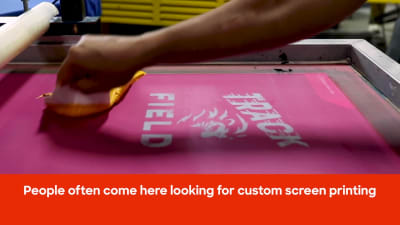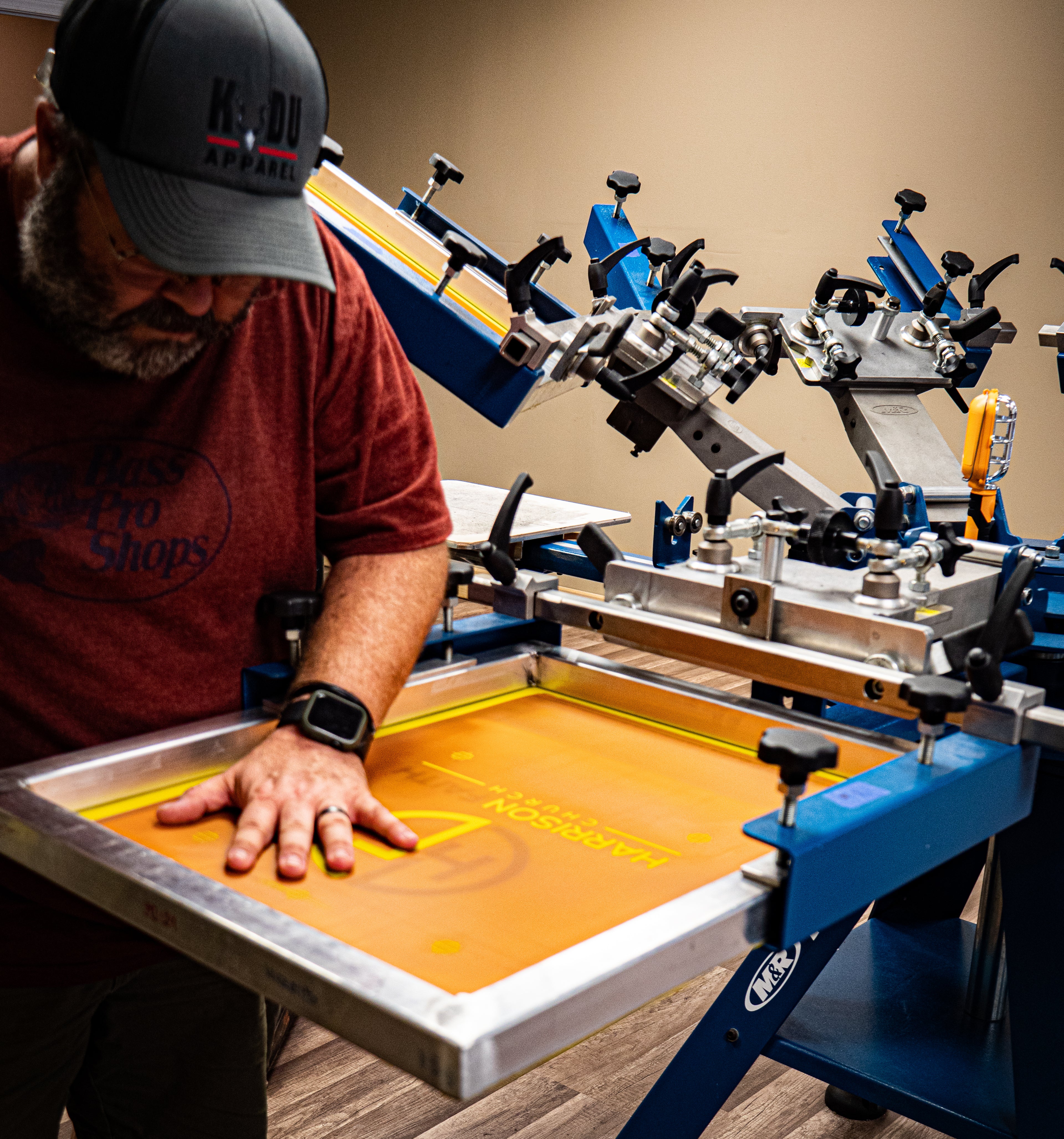High-Quality Custom Screen Printing for Team Apparel
High-Quality Custom Screen Printing for Team Apparel
Blog Article
Understanding Silk Screen Printing: Advice for Creating Stunning Layouts
If you're looking to grasp silk screen printing, you'll require more than simply enthusiasm. By the end, you'll be ready to produce magnificent styles that show your special style.
Recognizing the Fundamentals of Silk Screen Printing
Silk screen printing, commonly called screen printing, is a versatile method for transferring styles onto different materials. You'll find it's ideal for printing on textiles, paper, plastic, and more. The procedure includes creating a pattern, or display, that permits ink to travel through only in specific locations, creating tidy and lively designs.
To get going, you'll require to prepare your art work, guaranteeing it remains in an ideal style. screen printing kit. You'll layer your screen with a light-sensitive emulsion and subject it to light as soon as you've obtained your layout prepared. This step creates a stencil of your layout on the display
After washing out the unexposed solution, you're readied to publish. Align your screen over your product, apply ink, and use a squeegee to press the ink via the screen. It's everything about technique and persistence, so don't hesitate to experiment and improve your method as you go.
Essential Tools and Materials You'll Need
To start with silk screen printing, you'll require a couple of fundamental supplies like displays, mops, and ink. You can explore sophisticated devices that improves your printing quality and performance once you're comfortable. Allow's review what you'll need to guarantee your tasks are successful from the beginning.
Fundamental Silk Display Materials
Beginning on a silk display printing task calls for a couple of essential devices and products to guarantee your success. You'll require a silk display framework, which holds the mesh that transfers your design. A squeegee is necessary for pushing ink via the display onto your substratum.
Advanced Printing Equipment
When you're prepared to take your silk screen printing to the next degree, spending in sophisticated printing equipment can make a significant distinction. A top quality display printing press is crucial; try to find a multi-color press that permits specific enrollment and quicker production. You'll likewise want to update to a more reliable direct exposure device to ensure your designs are sharp and vivid.
Take into consideration purchasing a reputable warmth resource, like a conveyor clothes dryer, for even curing of inks. Do not ignore specialized inks; water-based and discharge inks give exceptional outcomes on different textiles. A good collection of mops and solution scoop coater will enhance your process, offering your styles that expert side.
Preparing Your Artwork for Printing
Preparing your artwork for silk display printing is vital to accomplishing vibrant, professional results. Beginning by validating your layout is in the appropriate format-- vector data like.AI or.EPS job best.
As soon as your documents prepares, develop a separate layer for each color in your design. This'll make it simpler throughout the printing procedure. Do not forget to include enrollment marks to align colors correctly.
Also, take into consideration the mesh matter of your screen; better details might call for a higher mesh matter. Save your artwork with a resolution of at the very least 300 DPI to ensure crisp prints. By complying with these steps, you'll set yourself up for a successful printing experience and bring your styles to life wonderfully.
The Display Printing Process: Step-by-Step
Since you've prepared your art work, it's time to concentrate on the screen printing procedure itself. You'll begin by preparing your screen, guaranteeing it awaits the ink application. From there, you'll check out different printing strategies to achieve the very best outcomes for your project.
Preparing Your Screen
Obtaining your screen all set is a critical step in the silk screen printing process. As soon as completely dry, position your openness on the display and make use of a light resource to subject the style. After direct exposure, clean out the unexposed solution, and you'll have your display prepared for printing.
Printing Strategies Clarified
When your display is ready, you can dive into the interesting procedure of printing. Initially, location your display on your substratum-- whether it's textile, paper, or another product. Safeguard it to stop any movement. Next off, pour your ink onto one side of the display and utilize a squeegee to draw the ink across the design. Apply even press to ensure the ink permeates via the mesh. Lift the display thoroughly to expose your print. If you're layering colors, let each layer completely dry before applying the next. Tidy your screen without delay to stop ink from drying and obstructing the mesh. With practice, you'll look what i found grasp the nuances of stress and timing, which will certainly aid you accomplish crisp, dynamic layouts.
Tips for Achieving Vibrant Colors
While attaining dynamic colors in silk screen printing might seem challenging, you can conveniently boost your designs with a few key strategies. First, choose premium inks particularly made for silk display printing; they offer better coloring and coverage. Mixing inks correctly can likewise improve vibrancy-- explore ratios to discover the perfect blend that stands out.

Finally, do not forget curing your prints correctly. Correct warm setting warranties the shades bond with the material, maintaining their vibrancy in time. By applying these methods, you'll create spectacular, attractive styles that really beam.
Fixing Common Printing Concerns
Also with lively shades in your layouts, silk display printing can sometimes provide obstacles. One typical issue is ink bleeding, which frequently happens when you utilize way too much ink or do not allow the previous layer dry completely. To prevent this, make use of a squeegee with just the appropriate pressure and ensure each layer is dry Visit Your URL prior to including a lot more.
If your layout isn't lining up properly, ascertain your registration marks and make changes to your screens. Clean your screens thoroughly prior to beginning your print run.
Finally, if the ink isn't sticking well to the material, think about the material type and the treating process. See to it you're utilizing the appropriate ink and that you're healing it at the suitable temperature level. Fixing these usual issues will certainly help you achieve sensational results.
Try out Results and methods
Experimenting with different strategies and results can boost your silk display printing tasks to new heights. You can likewise play with appearances-- making use of different squeegee techniques or integrating products like brushes or sponges includes dimension to your prints.
Consider utilizing specialty inks, such as metal or glow-in-the-dark, to offer your styles an unexpected spin. You could even check out stenciling, where you can reduce intricate layouts for magnificent impacts.
Do not ignore substratum variations! Printing on materials, wood, or paper can yield different results that enhance your project's feel.
Finally, keep a journal of your experiments. Recording your failures and successes will guide your future productions find and help you refine your design. Welcome the process, and delight in the journey of uncovering what jobs best for you!
Often Asked Questions
How Do I Clean and Preserve My Display Printing Equipment?
To cleanse and keep your screen printing equipment, regularly scrub displays with an appropriate cleaner, clean squeegees after use, and store whatever in a completely dry, dust-free environment. Keeping things neat assurances much better prints and longer-lasting tools.

Can I Publish on Materials Besides Material?
Yes, you can print on materials apart from textile! Take into consideration making use of timber, paper, or plastic. Simply make certain your screens and inks work with those surface areas for the finest results. Experiment and have a good time!
What Is the most effective Way to Store Screens and Inks?
To keep displays and inks successfully, maintain screens upright in an awesome, dry location, and cover them to prevent dust. Store inks in closed containers, far from direct sunlight, to preserve their high quality and consistency.
Just how Do I Select the Right Mesh Count for My Task?
Selecting the appropriate mesh matter relies on your design's detail and ink type. For fine information, go higher, like 200 mesh (screen printing kit). For vibrant styles, a reduced matter, around 110, functions best. Experiment to discover your optimal suit.
What Are the Environmental Impacts of Silk Screen Printing?
Silk display printing can have ecological impacts, like chemical waste and water usage. You can decrease these by utilizing green inks, reusing materials, and correctly disposing of chemicals to reduce your task's environmental impact.
Silk screen printing, frequently called screen printing, is a flexible technique for transferring styles onto different products. Straighten your screen over your material, apply ink, and use a squeegee to push the ink via the screen.To get begun with silk screen printing, you'll need a few standard supplies like screens, squeegees, and ink.When you're all set to take your silk display printing to the following level, spending in innovative printing equipment can make a significant difference.Getting your screen all set is an important step in the silk screen printing procedure.
Report this page